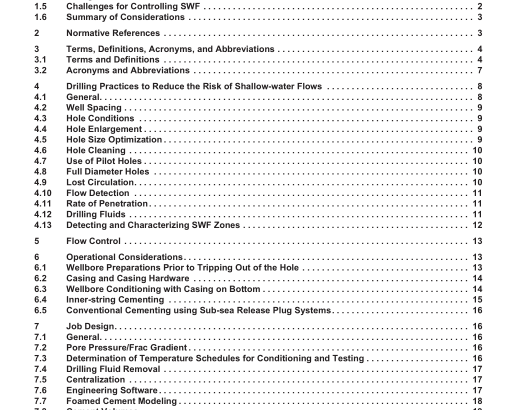API 65-1:2018 pdf free download.Cementing Shallow-water Flow Zones in Deepwater Wells
This standard describes practices designed to prevent shallow-water flow (SWF) during and following the cementing of wells located in deepwater. It is the compilation of technology and practices developed and used by many operators around the world. Although most of the discussion in this standard is focused on SWF, shallow flows can be mixtures of water, gas, gas hydrates, and formation fines.
There is no single method of preventing shallow-water flow, and many of the activities described may require customization to fit individual well conditions. While this standard is extensive, it is not meant to limit innovation and new technology. The content of this document is not all inclusive, and guidance from other sources may apply. Note that this standard is not meant to be a stand-alone training manual or well design standard. Although fairly comprehensive, there are still many details that are not discussed and that should be addressed when drilling and cementing wells in deepwater. It is meant to highlight key parameters for increasing the chance of successfully drilling and cementing casings where there is a risk of shallow- water flow and to discuss options that are available. More details can be gleaned from the references listed in the bibliography.
Most of the information in this document is from U.S. Gulf of Mexico experience. The concepts can be applied in other deepwater environments with appropriate modifications. The user should consult experts within the industry for specific details of the cementing process relating to the technology being used by a specific company for a specific scenario. The construction of the casings through the SWF zones should be a team effort to be successful. All parties involved shall participate in the planning and execution of all phases of the process to ensure successful construction of the conductor and surface casings. In this standard, where practical, U.S. customary units (USC) are included in parentheses for information.
The units do not necessarily represent a direct conversion of metric units (SI) to USC units, or USC to SI. Consideration has been given to the precision of the instrument making the measurement. For example, thermometers are typically marked in one-degree increments; thus, temperature values have been rounded to the nearest degree.
1.2 Objective
The objective of this standard is to communicate methods to prevent shallow-water flows in the tophole sections of deepwater wells during and after cementing operations.
1.3 Conditions of Applicability
This document is applicable to the following well conditions:
— tophole section(s) of the well;
— shallow hazard assessment concludes a risk/potential for shallow flow.
This does not include isolating potential flow zones beyond the tophole section(s) of the well; see API Standard 65-2.
1.4 Background
SWF are water flows from permeable formations at shallow depths below the mudline in wells drilled in deep ocean waters. The water flows can compromise the structural or hydraulic integrity, or both, of the tophole section(s). The tophole section is a part of the well often drilled without a marine riser where drilling and cementing fluids exit the well annulus at the seafloor. SWF can occur in sections drilled with a riser where fluid returns are at the rig. Modes of failure include:
— poor isolation by cement resulting in casing buckling/shear;
— pressure communication to other shallow formations, causing them to be overpressured;
— disturbance of the seafloor due to breakthrough of the shallow flow to the mudline.
NOTE Such damage can result in the complete loss of drilling templates containing previously cased well.API 65-1 pdf download.API 65-1:2018 pdf free download
